Collard greens and spinach are tasty, healthy plants with an abundance of vitamin-packed leaves, but can you tell the difference? Let’s discover how spinach is different from collard greens.
What Are The Main Differences Between Collard Greens vs. Spinach?
Both these leafy vegetables are great for health, they are green and able to cope with cold temperatures, but there are a few differences between them. The main differences are collard greens are larger, have tougher leaves, and they’re more cold-tolerant. In terms of taste, spinach has a more bitter flavor than collard greens.
| Collard Greens | Spinach | |
|---|---|---|
| Name | (Brassica oleracea subsp. Viridis) | (Spinacia oleracea) |
| Foliage | Dark green with white veins, smooth, flat and large | Small and mid-green, thin without veining |
| Flowers | Tiny yellow crosses | Tiny white bells |
| Growing Zone | 4 and above | 4 and above |
| Native To | Mediterranean but grown worldwide | The Middle East but grown worldwide |
| Perennial or Evergreen | Biennial | Annual |
What Are Collard Greens?
Collard greens are a green, leafy vegetable in the Brassica oleracea family, subspecies Viridis. Viridis veggies have loose heads of leaves as opposed to some cabbages and veggies like broccoli that have tightly packed heads.
The name collard is an old English medieval word “colewort” that described loose, leafy vegetables that didn’t have a head. Colewort vegetables have a long history in the human diet. Thousands of years ago the ancient Greeks and Romans cultivated them and we still eat them today. Collard greens are particularly popular in the southern United States and are an essential ingredient in a mixed green salad along with spinach and kale.
Here’s an interesting fact. Collard greens are 90 percent water when they’re raw and packed full of vitamins A, C, and manganese.

Collard greens are 90 percent water when they’re raw.
©iStock.com/bhofack2
What Is Spinach?
Spinach is also a green leafy vegetable but it’s in the Amaranthaceae family and subfamily Chenopodioideae. Confusingly many leafy greens are called spinach.
Its English name is taken from the 14th-century French word “espinache” which derives from the ancient Persian “aspanak”. Spinach has been eaten for thousands of years with references to its cultivation in Ancient Persia (today’s Iran) and India. It was introduced to northern Europe in the 14th century and became popular because few leafy greens were available in very early spring.
Raw spinach is 91 percent water, and it’s also packed with vitamins. It’s particularly well known for its iron content.
An interesting fact about spinach is that during World War I, wine was boosted with spinach juice and given to injured soldiers.
Collard Greens vs. Spinach: Where are They From?
Collard greens are native to the Mediterranean but cultivated worldwide, whereas spinach is native to the Middle East.
Growing Zones for Collard Greens vs. Spinach
Collard greens are a cool-season veggie that thrives in most growing zones. You can successfully grow them in Zones 4 and above. In Zone 8 and above, they can be repeatedly harvested.
Spinach is much the same. It grows in Zone 4 and above and can be harvested a second time in hot zones.

Collard greens grow in Zone 4 and above, just like spinach.
©iStock.com/EvergreenPlanet
Are Collard Greens and Spinach Annuals?
Collard greens are naturally biennial, which means they germinate and grow some leaves in year one, then flower and seed in year two. In warm climates they are perennial.
Spinach is generally grown as an annual, but it will continue to grow in warm climates like a perennial.
Collard Greens vs. Spinach: Foliage
Both species have loose green leaves, but that’s where the similarities end.
Collard greens grow up three feet tall on a thick, woody stem and have large, dark green paddle-like leaves with white veins and smooth edges. They look like loose-headed cabbages.
In contrast, spinach doesn’t get as tall. It only reaches a foot or less in height and has smaller dark green leaves without veining on a fleshy stem.
Overall, spinach’s small, thin leaves appear much less hardy than collard greens, with thicker foliage.
Collard Greens vs. Spinach: Flowers
Spinach flowers are tiny, white, and produced on conical spikes at the very tip of the leader stem. Collard green flowers are also tiny, but they are yellow with four petals in the form of a cross. They develop in large sprays at the tip of the leader stem.
Both spinach and collard green flowers are edible and have a sweet, mild cabbage flavor.
Another similar aspect between collard greens and spinach flowers is their tendency to bolt. Bolting means to flower and set seed suddenly, even if it’s the middle of their growing season. If they bolt, it’s usually down to drought. Cut off the flowers and give them lots of water.
How To Grow Collard Greens vs. Spinach
Collard greens grow over winter, ready for harvest in spring and summer.
- Plant seeds a month before late fall sets in. You can grow them directly in a vegetable bed or in pots ready to transfer.
- They get wide, so leave at least 20 inches between each seed. If you sprinkle numerous seeds, thin out seedlings later on.
- Keep the seeds damp but not soggy.
- When the seedlings appear, keep weeds down and apply a layer of rotted organic mulch to fertilize them. If you’ve started collard greens in a seed pot, transfer them when they reach six to eight inches tall.
- In windy areas you may need to stake growing plants. Wind leads to root rot so the plant can’t suck up enough nutrients to grow.
- Protect them against deer, rabbits, and birds that can strip a collard green plant to its stalk.
- Leaves are ready for harvest when they reach 10-12 inches long, but if you like sweeter flavors pick the baby leaves. Pick the lower leaves first.
- Keep watering, fertilizing, and harvesting until no more leaves appear. Then it’s time to compost the stem.
- Collard greens will grow in large, well-watered raised beds and containers on a balcony too.
Growing spinach is similar, but the seeds are planted in early spring, not late fall.
- Plant seeds in early spring from February onwards. There are some winter cultivars that can be planted in fall.
- Sprinkle the seeds in a drill and when seedlings appear, thin them to three inches apart.
- Water, fertilize, and keep weeds at bay. You may need to cover spinach to protect it from birds, rabbits, and deer.
- Add mulch and keep watering to prevent bolting.
- Spinach is usually ready for harvest in late spring onwards. Winter cultivars are ready from October.

Spinach is planted in the spring, while collard greens are planted in the fall.
©iStock.com/SylvieBouchard
Can Dogs Eat Collard Greens and Spinach?
Dogs can eat both collard greens and spinach. In fact, it’s good for them in small amounts.
How To Cook Collard Greens vs. Spinach
Collard greens and spinach are very tasty and good for your health. Both can be eaten raw or cooked, so they are very versatile greens.
Collard greens are used extensively in the southern United States in mixed salads, whereas spinach is very good raw in sandwiches, soups, and as garnish on casseroles or stews. Collard greens generally need cutting very fine or steaming before they are soft enough to eat, but spinach leaves can be cooked whole.
Do Collard Greens Taste Like Spinach?
Collard greens have a fresh, mild taste and spinach is more bitter. Both are very tasty!
How To Protect Collard Greens and Spinach From Snails
Slugs and snails do a great deal of damage to leafy greens. In the depths of a cold winter they’re not too much of a problem, but when spring arrives they’re out in force looking for a meal.
One of the best ways to keep mollusks off collard greens is copper rings. Collard greens have a thick woody stem that snails have to climb. Attaching a copper ring gives snails a mild shock that prevents them from crawling any further.
Other methods of snail protection are broken eggshells, wool, and . It’s always a good idea to rake over the soil and upturn stones or wood near your greenery because slugs and snails like to take cover in damp wet places.
Which Is Best: Collard Greens or Spinach?
Both these leafy greens are packed with vitamins and cope with colder weather, but which is best?
Collard greens have a mild taste compared to spinach which is bitter. They’re also more cold-tolerant and provide more leaves for the pot. However, spinach is more popular raw and it has a more interesting taste.
The choice is yours, but for maximum health grow both!
Up Next
- Collard Greens vs. Kale: What’s the Difference?
- Swiss Chard vs. Collard Greens: What’s the Difference?
- What’s the Difference Between Mustard Greens and Collard Greens?
The photo featured at the top of this post is © New Africa/Shutterstock.com
Sources
- , Available here: https://a-z-animals.com/wp-admin/post.php?post=434394&action=edit
- , Available here: https://a-z-animals.com/wp-admin/post.php?post=434394&action=edit
- , Available here: https://a-z-animals.com/wp-admin/post.php?post=434394&action=edit
Thank you for reading! Have some feedback for us? Contact the AZ Animals editorial team.






